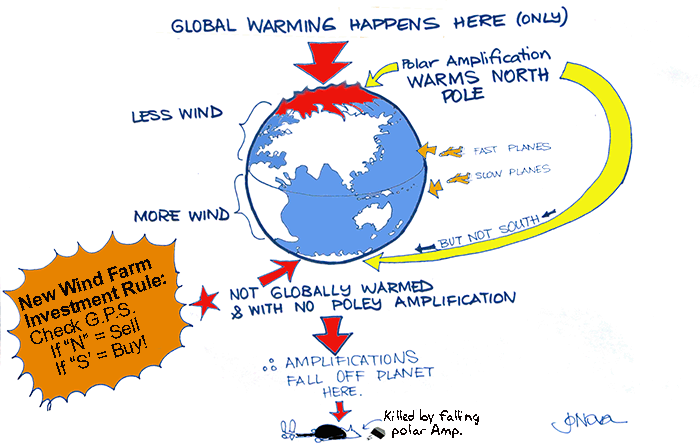After building 341,000 wind turbines, mostly in the Northern Hemisphere, now climate modelers reveal that winds will decrease in the Northern Hemisphere!
Warming temperatures caused by climate change are set to weaken wind energy in the northern hemisphere, a study shows, lessening the amount of wind power produced for wind farms.Rush, invest your money now. The theory called polar amplification has the success rate of a coin toss. Buy a wind farm in NE Australia!
However the southern hemisphere would see a boost in wind, which could potentially turn north-eastern Australia into an attractive investment for energy companies.
Luckily wind speeds are not also influenced by cloud cover, jet streams, oceans currents, forest growth, atmospheric tides, solar factors, magnetic fields, ozone levels, cosmic rays, or butterflies. Otherwise this study might be inadequate, uninformed guesswork being used to inform investment decisions!Key points:
- Atmosphere instability which creates wind changing in northern hemisphere
- North-east Australia could become an attractive investment for energy companies
- At present there is only one operational wind farm in Queensland
Wind usually derives its energy from an instability in the atmosphere, and in the northern hemisphere a major source of that instability is the equator to pole temperature difference," he said.Yes, polar amplification, is called "polar" for a reason, and it's wrong. The South Pole is a Pole too. (And Arctic has a c in it.)
"We all know that the tropics are warmer than the arctic, but because the artic is warming at a much faster rate than the rest of the world - including the tropics and the latitudes - that temperature gradient is lessening.
"That is a well known phenomenon called polar amplification, or artic amplification."
But wait til you hear why winds are speeding up in the Southern Hemisphere:
It found in the southern hemisphere the difference between the average land and sea temperature was increasing, which would push greater wind production.Call it cartoon science. Two dimensional and with reasoning by the Road Runner. To be fair, the ABC didn't ask a skeptical scientist for their opinion on the science but they did ask a climate scientist for his opinion on investments:
"As we know most of the southern hemisphere is dominated by ocean, relative to the northern hemisphere," Professor Karnauskas said.
So in South America, the southern half of Africa and Australia, greenhouse gas warming was expected to increase the temperature over land faster than over the ocean. "The land-sea temperature difference in the southern hemisphere is actually increasing because the land is warming up so rapidly relative to the ocean," he said.
"So the winds are able to derive greater energy from that temperature difference or instability."
US could face drop in wind energyThe ABC didn't interview wind farm critics either, but they found space to interview a wind farm activist:
For Australia, Professor Karnauskas said he expected there would be a boom in wind energy for the north-east of the country.
"This information may prove key in allocating resources and planning, for example where and when to build new farms and how to deal with differed maintenance with older wind farms," he said.
"And helping to fine-tune the blend of renewables supporting the every growing regional energy consumption.
"It doesn't mean that wind energy should take the place of any other part of the portfolio that's in a strategy to reduce greenhouse gas emissions."
Professor Karnauskas' study reported the central United States could face a 10 per cent drop in available wind energy by 2050.
And by the year 2100, that could be up to 40 per cent.
The idea that the Trump administration could use the report to push for a drop in wind energy investment was something Professor Karnauskas said he was nervous about.
"Wind power is and should remain considered as an important part of the portfolio of renewable investments as part of the broader strategy to reduce carbon emissions," he said.
Andrew Bray, from the advocacy group Australian Wind Alliance, said he doubted a predicted boost in available wind energy in Queensland would make much of a difference in the level of wind farm investment.
He said there was already enough wind to go around.
"There's incredible wind resources all across Australia," he said.
"We recently had some research done which estimated that we could power Australia's entire energy needs 12 times over just with the wind resources in eastern Australia.Twelve times over! All we need is infinite money, and unlimited free lithium and cobalt. A gift. A gift at half the price. Let's use the $1b ABC budget to buy up wind farms and let the ABC run off those profits. But cancel that damn RET first.
UPDATE: The researchers say there are three problems with GCM's
Jo says "just three?"
The first... The resolution ... is typically on the order of 1-2° or ~100 km.Someone tell the researchers not to worry. The GCM's other limitations include that they can't predict the global temperature, historic long term temperatures, nor the regional, local, short term[1] [2] variations, they're wrong about polar amplification [3], and can't get the upper tropospheric pattern right either [4] [5]. Being comprehensive, they also fail on humidity[6], rainfall[7], drought[8] and they can't do clouds[9]. See the references here.
The second ... is that wind turbines integrate momentum from wind across the rotor disk, typically 40-120 m above the surface, whereas... wind information is available only at a height of 10 m and on standard pressure levels (for exmple, 1,000 mbar, 925 mbar, 850 mbar, and so on).
The third potential limitation of GCMs is the provision of monthly mean fields, whereas winds fluctuate at much higher frequencies...




Reader Comments
to our Newsletter